Buying Guide: Discontinued and Reclaimed Tiles
 Are you looking for your tile online but can't find it? Unfortunately the tile you have might not be in production anymore.
Are you looking for your tile online but can't find it? Unfortunately the tile you have might not be in production anymore.
You might be in luck as we have a limited supply of second hand discontinued tiles kicking around out our depots. However, failing this, Burton Roofing Merchants have compiled a list of discontinued tiles, along with our suggestions on a current similar tile on the market.
Below are categorised in 2 tables: Concrete and Clay.
Concrete
| Image | Name | Description |
|---|---|---|
 |
"ANCHORLITE" (Forticrete) | Small, relatively-lightweight single-interlocking "slate-effect" tile. The rear of the tile, which just shows the name 'Anchor', has two small slim support nibs. |
 |
"CALEDONIAN" (Redland) | A large-format heavy interlocking tile similar in profile to the Double Roman but measuring both longer and wider. Its name is a clear indication of its country of manufacture. |
 |
"DELTA" (Redland) | Easily the most distinctive profile of any large-format concrete tile, having a pronounced triangular-shaped peak running from top to bottom down the middle of the face. Often used in alternating columns with Mk II Stonewold. Note: Requires matching ridge tile which is notched out to accept the corresponding triangular peak. |
 |
"GRAMPIAN" (Annandale) | Forerunner of the current version, now manufactured by Russell this original pattern of flat interlocking tile has a single continuous nib across the top edge instead of two separate nibs displayed by its modern counterpart. |
 |
"LINCSWOLD" (Goxhill) | A large concrete single pantile, both longer and wider than the many similar-looking but smaller alternatives still on the market (e.g. Anglia, Norfolk and Shire). However very similar to the old Redland 52 in size and profile. |
 |
"MERCIAN" (Sandtoft) | Despite having its name clearly shown on the reverse, this large heavy interlocking tile is often mistaken for the Marley 'Wessex', although both longer and wider than its smaller competitor. Undeniably similar in appearance when laid on the roof the difference is apparent, in the case of the Mercian, through the more heavily-profiled right-hand crown. |
 |
"TYZACK" | A medium-sized flat-ribbed single-interlocking tile usually with a dull pink tint through the concrete. Name clearly visible on the rear, though often understandably mistaken for the Redland 49, and for which it is an obvious alternative. |
 |
BOLD-ROLL (Marley) | This heavily-profiled double-roll interlocking tile has only recently been withdrawn from production. However the position of these rolls relative to the interlock means it is not compatible with tiles of similar style from other manufacturers, e.g. Redland 'Regent'. |
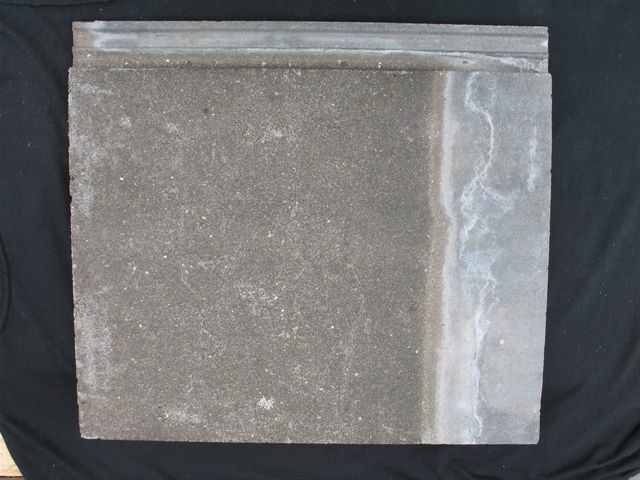 |
DANUM 'SLATE' (Sandtoft) | A large flat interlocking tile (not slate) usually without nail holes. Has two heavy nibs on the rear face set down from the top edge. Compatible with Redland Mk II Stonewold. |
 |
HARDROW "SLATE" (Forticrete) | A large, flat and heavy non-interlocking concrete slate, laid in staggered bond and designed to replicate the appearance of natural stone slate. Comes in three different sizes - (18x12), (18x18) and (27x18). Matching 3-ft long ridge tiles in a variety of angles. |
 |
REDLAND 49 (Mk I) | The classic medium-sized, flat-ribbed single-interlocking tile, usually with a dull pink tink to the concrete, clearly displays the manufacturers name on the reverse though not the pattern number. Completely straight when viewed side-on, it is not compatible with its modern updated version which has a top-to-bottom camber. |
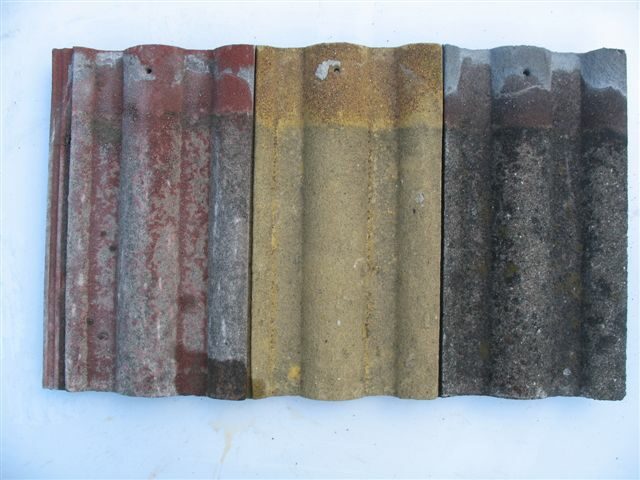 |
REDLAND 51 | A widespread and popular double-roll single-interlocking tile which is the diminutive version of the Double Roman. Manufacturers name and pattern number usually clearly visible on the reverse. Various colours and tints available as stocks rotate. |
 |
REDLAND 52 | A large concrete single pantile, both longer and wider than the many similar-looking but smaller alternatives still on the market (e.g. Anglia, Norfolk and Shire). However very similar to the Goxhill Lincswold in size and profile. |
 |
STONEWOLD Mk II (Redland) | A large flat interlocking tile usually without nail holes. The position of the two chunky individual nibs set a little way down on the rear face are what distinguishes it from the original Mk I version which has much smaller nibs directly along the top edge. Compatible with 'Danum'. |
 |
WESSEX (Marley) | An essentially flat tile but with raised left and right-hand edges that interlock to form a 'trapezoidal' crown and an overall profile, when laid, reminiscent of a box-profile sheet. Often found on shallow pitched roofs. |
Clay
| Image | Name | Description |
|---|---|---|
 |
"BABY" Gaelics | As the name suggests, a small version of the classic pattern showing all the usual features. Ideal for small porches and garden features, e.g. wishing wells. |
 |
"COUNTY" PANTILE (Mixed Russet) | A modern double-interlocking natural clay pantile made by Goxhill/Sandtoft. Although this classic pattern is still in production, the 'mixed-russet' colour (i.e. a black shading towards the bottom of the tile) is now obsolete. |
 |
"Courtrai" Style BEAUPREZ & GRUYELLES Wahagnes Thu | A small double-interlocking clay tile usually of Belgian or French origin, of which there are several different patterns in existence. Basically flat with a small roll to the right hand side, the tile is usually identified by the two upside-down semi-circular 'lugs' on the front face. |
 |
"COURTRAI" STYLE Dalle/Wervico | A small double-interlocking clay tile usually of Belgian or French origin, of which there are several different patterns in existence. Basically flat with a small roll to the right hand side, the tile is usually identified by the two upside-down semi-circular 'lugs' on the front face. |
 |
"COURTRAI" STYLE Marcke les Courtrai | A small double-interlocking clay tile usually of Belgian or French origin, of which there are several different patterns in existence. Basically flat with a small roll to the right hand side, the tile is usually identified by the two upside-down semi-circular 'lugs' on the front face. |
 |
"COURTRAI" STYLE Monopole (Tuileries du Nord) | A small double-interlocking clay tile usually of Belgian or French origin, of which there are several different patterns in existence. Basically flat with a small roll to the right hand side, the tile is usually identified by the two upside-down semi-circular 'lugs' on the front face. |
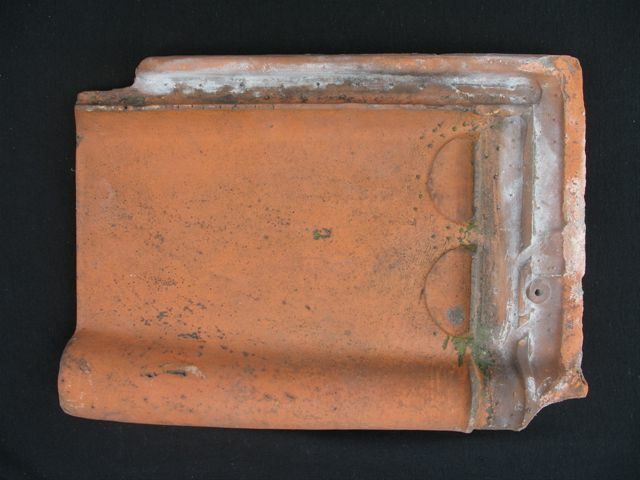 |
"COURTRAI" STYLE Pottelberg | A small double-interlocking clay tile usually of Belgian or French origin, of which there are several different patterns in existence. Basically flat with a small roll to the right hand side, the tile is usually identified by the two upside-down semi-circular 'lugs' on the front face.This tile has a deeper red finish to the natural terracotta of the tile. |
 |
"COURTRAI" STYLE Sterreberg | A small double-interlocking clay tile usually of Belgian or French origin, of which there are several different patterns in existence. Basically flat with a small roll to the right hand side, the tile is usually identified by the two upside-down semi-circular 'lugs' on the front face. This tile has a matt black finish. |
 |
"COURTRAI" STYLE Watten (Tuileries du Nord) | A small double-interlocking clay tile usually of Belgian or French origin, of which there are several different patterns in existence. Basically flat with a small roll to the right hand side, the tile is usually identified by the two upside-down semi-circular 'lugs' on the front face. |
 |
"Poulet" Style BEAUPREZ & GRUYELLES | Small double-interlocking half-bonded tile with distinctive inverted wine glass pattern (often called by the name "Poulet" or "Le Forest"). |
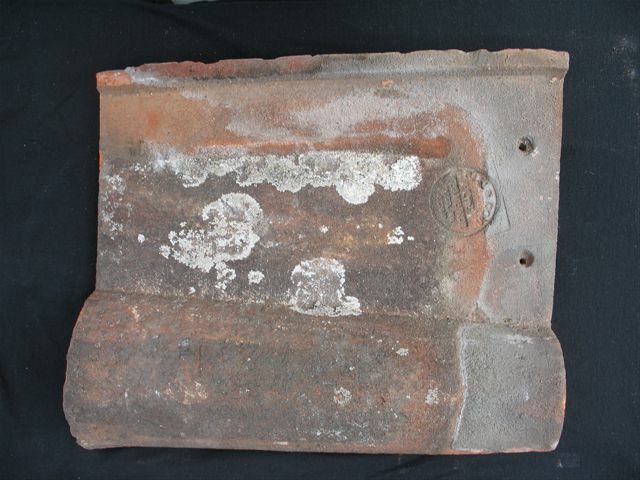 |
BAMBINO (C S Coy Ltd) | A smaller-format terracotta tile with a flat body and a large tapering bold-roll on its right hand side. Although a British-made tile, both its style and the name (which is usually visible on the manufacturers circular stamp, or sometimes imprinted on the rear) clearly show its Italian/Roman heritage. |
 |
BEAUVAIS Tuileries de Beauvais | A decorative double-interlocking French clay tile with a distinctive raised diamond or "lozenge" pattern in the centre of the face. This pattern is slightly deeper and heavier than other Beauvais tiles, and it has a larger diamond. There is also a lattice pattern on the reverse side showing two letters inside a large diamond (letters and diamond may vary). This tile has a "crinkled" pattern across the front face. |
 |
BEAUVAIS Tuileries de Beauvais | A decorative double-interlocking French clay tile with a distinctive raised diamond or "lozenge" pattern in the centre of the face. This pattern is slightly deeper and heavier than other Beauvais tiles, and it has a larger diamond. There is also a lattice pattern on the reverse side showing two letters inside a large diamond (letters and diamond may vary). |
 |
BEAUVAIS Tuileries de Beauvais | A decorative double-interlocking French clay tile with a distinctive raised diamond or "lozenge" pattern in the centre of the face. |
 |
BOROUGHBRIDGE | A classic red clay tile with a flat pan and an almost triangular shaped "roll" on its right hand side. Its distinguishing feature is the two parallel weather-bars running vertically down the left hand side. This particular pattern has the Boroughbridge name stamped across its top edge, somewhat rounded 'mitres' to its top right and bottom left corners, and a single nail hole positioned on the roll. |
| BOROUGHBRIDGE (Green-Coated) | A classic red clay tile with a flat pan and an almost triangular shaped "roll" on its right hand side. Its distinguishing feature is the two parallel weather-bars running vertically down the left hand side. This particular pattern has the Boroughbridge name stamped across its top edge, somewhat rounded 'mitres' to its top right and bottom left corners, and a single nail hole positioned on the roll. With a factory-applied matt green finish. | |
 |
BOROUGHBRIDGE J W GREEN PATENT | A classic red clay tile with a flat pan and an almost triangular shaped "roll" on its right hand side. Its distinguishing feature is the two parallel weather-bars running vertically down the left hand side. This particular pattern has the Boroughbridge name stamped onto the upper front face between its two nail holes. Angled mitres to top right and bottom left shoulders. |
 |
BRIDGEWATER Double Roman | The original classic Double Roman in unfinished natural red clay, having two tapering rolls and mitred corners on top right and bottom left shoulders. |
 |
CELTIC | A traditional clay tile basically flat in design with a small tight roll to its right-hand side and mitred corners to top right and bottom left. Carries no weather bar unlike the similar-looking Gaelics and Boroughbridge. |
 |
CELTIC | Another version of this popular tile with its name clearly visible in an upside-down oval-shaped stamp at the top of the front face. Although clearly a Celtic it is arguably more Gaelic-like in its appearance with a generally heavier feel, a larger than normal roll and two deep nibs on the rear instead of the usual one. |
 |
CELTIC | A traditional clay tile basically flat in design with a small tight roll to its right-hand side and mitred corners to top right and bottom left. Carries no weather bar unlike the similar-looking Gaelics and Boroughbridge. This version has a dark fine sanded/textured finish. |
 |
CELTIC (H W & Co. Ltd) | A traditional clay tile basically flat in design with a small tight roll to its right-hand side and mitred corners to top right and bottom left. Carries no weather bar unlike the similar-looking Gaelics and Boroughbridge. Manufacturers name is stamped into the top edge of the tile above the nibs. |
| CHAGNY Large (Tuileries Bourguignonnes Chagny S et L France) | An interlocking clay tile easily recognised by the raised diamond pattern in the centre of the tile. Often mistakenly referred to as large 'Beauvais'. This tile has a more elaborate elongated diamond or "lozenge" than its smaller version. | |
 |
CHAGNY Small (Tuileries Bourguignonnes Chagny S et L France) | A decorative double-interlocking French clay tile with raised diamond or "lozenge" pattern central to front face. Very similar to, and often mistaken for, Beauvais. |
 |
CROSSLEY "TUDOR" MK I | A large, deeply-profiled terracotta pantile in double interlocking format. This original version has a 4"/100mm headlap and a series of four horizontal support lugs on the rear. |
 |
CROSSLEY "TUDOR" MK II | A large, deeply-profiled terracotta pantile in double interlocking format. This updated version has a smaller 3"/75mm headlap. Differs on the rear from the Mk I by virtue of a second interlocking rib running across the bottom of the tile parallel with the leading edge. |
 |
CROSSLEY "TUDOR" MK II | A large, deeply-profiled pantile in double interlocking format. This updated version has a smaller 3"/75mm headlap. Differs on the rear from the Mk I by virtue of a second interlocking rib running across the bottom of the tile parallel with the leading edge. This tile has a "mixed brindled/burnt-flame" effect finish. |
 |
Double Roman (Green) | Usual Double Roman profile but with larger tapering rolls and a striking deep-green ceramic glaze over the natural red clay of the tile. Nail holes angle down through two nibs on the top edge. |
 |
Double Roman Half-Bonded | Traditional Double Roman profile in this 'Guaranteed Hand-Made' tile with a dark-brown textured finish to the natural clay. Has the upper section of its central roll notched-out enabling it to be laid with a staggered bond. |
 |
GAELIC | An unnamed version of this popular tile in solid red clay bearing all the hallmarks of the traditional pattern, e.g. the single vertical weather bar. Although approximately the same overall size as the Barton-on-Humber, this type has only a single slim nib on the rear which results in slightly better overall coverage. |
 |
GAELIC | Bit of a hybrid this one. It carries the classic single weather bar traditionally associated with the Gaelic, although unusually it runs the full length of the tile from top to bottom. However it has a wider looking flat pan and a smaller tighter roll more reminiscent of the Celtic. Also has small rounded Celtic style nib on rear. |
 |
GAELIC Barton-on-Humber | A terracotta clay tile with a flat pan and overlapping roll to its right hand side. Characterised mainly by its single vertical weather-bar. This narrower version has a subtle camber from top to bottom, two deep nibs on the rear and a single nail hole positioned on the roll. |
 |
GAELIC Barton-on-Humber | A terracotta clay tile with a flat pan and overlapping roll to its right hand side. Characterised mainly by its single vertical weather-bar. This version has a subtle camber from top to bottom, two deep nibs on the rear and a single nail hole through the face. |
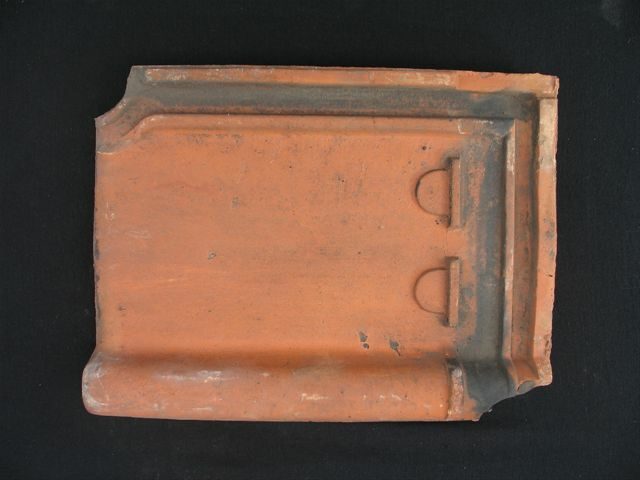 |
GEBR TEEUWEN TEGELEN | A small double-interlocking tile in the Dutch style. Often mistakenly referred to as 'Courtrai' (which is Belgian) but not compatible with these due to the lower position of the 2 nibs on the rear and the distinctive ?-circle drainage channel at the bottom left hand corner. |
| Gebr Teeuwen Tegelen KALDENKIRGHEN | A long, narrow double-interlocking tile with central vertical rib on front face characteristic of many continental tiles of this style. Laid in half-bonded (staggered) format. NB Sometimes the name 'Kaldenkirghen' is omitted or obscured by a third slim support nib located between the two standard nibs at either side. | |
| GILARDONI FRERES Brevette SGDG Bois du Roimarne | A long, narrow double-interlocking tile with central vertical rib on front face characteristic of many continental tiles of this style. Laid in half-bonded (staggered) format. | |
 |
GREENWOOD PATENT BOLD ROLL | A smaller format of tile, with a dark fine-textured finish, similar in style to the 'Bambino' but with an even more pronounced right hand bold roll accounting for nearly half the overall width of the tile. |
 |
GUICHARD CARVIN & CIE MARSEILLES ST ANDRE FRANCE | The classic half-bonded interlocking tile from the South of France with a narrow vertical rib central to the front face, 4 diagonal slits/scores on the right hand side and a 'Bee' logo embossed on the front and rear faces. |
 |
GUICHARD FRERES ST HENRI MARSEILLES FRANCE | The classic half-bonded interlocking tile from the South of France with a narrow vertical rib central to the front face, 6 diagonal slits/scores on the right hand side and a 'Lion' logo embossed between the nibs on the rear face. |
 |
HOMESTEAD | Another long-format clay tile from the Bridgewater factory with a small tight roll on its right-hand overlap. Main feature is the central roll which tapers off to meet the main body of the tile approximately halfway up the front face. As many as three different lengths of tapering roll are known to exist but this does not proclude any of the other patterns from being used for repairs. |
 |
JAC LAUMANS REUVER HOLLAND | A long, narrow double-interlocking tile with central vertical rib on front face characteristic of many continental tiles of this style. Laid in half-bonded (staggered) format. |
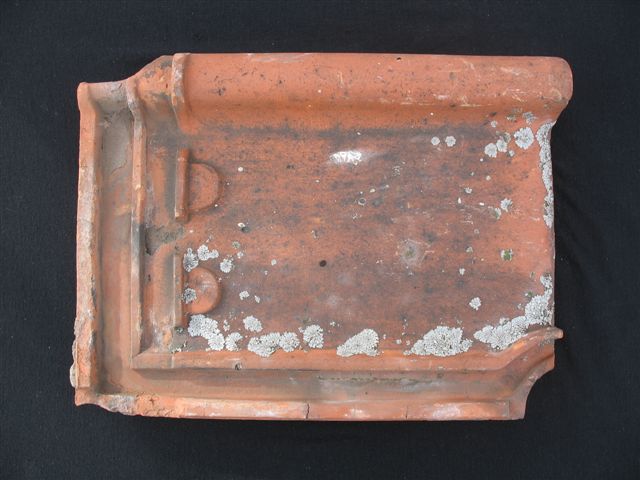 |
JD MADE IN HOLLAND (Tegelen) | A small double-interlocking tile in the Dutch Tegelen style. Often mistakenly referred to as 'Coutrai' (which is Belgian) but not compatible with these due to the lower position of the 2 nibs on the rear and the distinctive ?-circle drainage channel at the bottom left hand corner |
 |
John Board No. 11 Bridgewater Double Roman (Ochre) | A normal Double Roman pattern with the two standard sized tapering rolls and a light-brown ceramic glaze over the natural red clay of the tile. Has two nail noles on the front face. |
 |
Old English "Farmhouse" Hand-Made Pantiles | These traditional clay pantiles, mostly handmade, come in a wide variety of pan and roll depth from an almost flat pan to a very pronounced roll. Glass pantiles to match the above available in good quantities. |
 |
Pantiles Machine-Made | A more modern version of the traditional hand-made tile but more uniform in size and profile with properly defined nibs and mitred corners. |
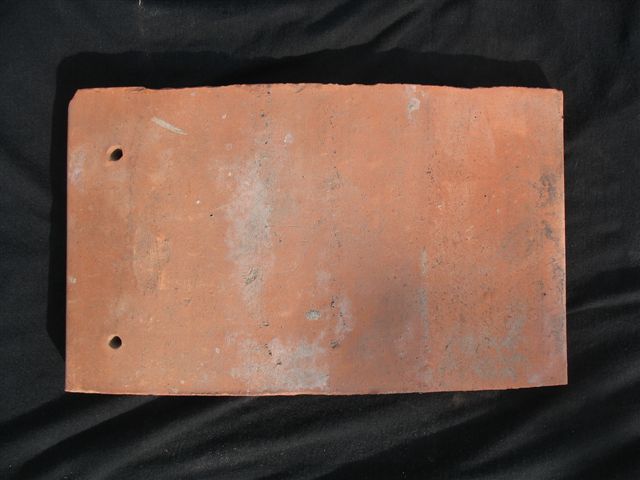 |
PLAIN 'PEG' TILE | A relatively thick plain tile in light terracotta with a solid continuous single nib unlike the two or three individual nibs normally associated with this style. |
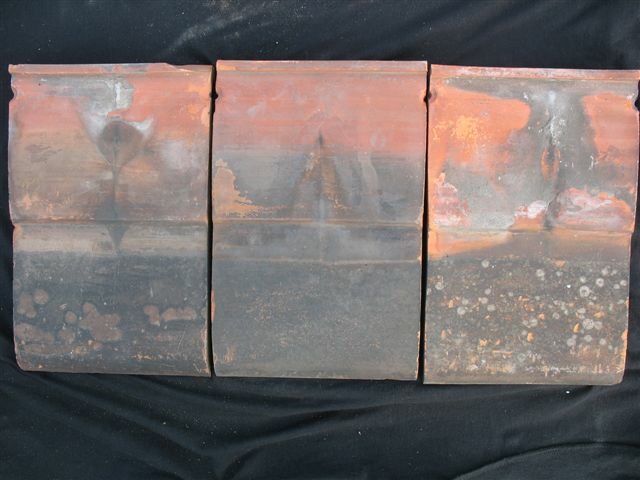 |
PLAIN 'WEATHERLOCK' TILE | A distinctively-engineered plain tile whose three main features, i.e. its curved leading edge, central horizontal step and continuous T-shaped front and rear nib all 'lock' the tile firmly into place at a predetermined gauge. Also has unusual countersunk nail holes on its edges which it shares with the neighbouring tile. |
 |
PLAIN CLAY TILES | Generally referred to by the classic name of 'Rosemary' this style of small flat clay tile is available in an ever-changing variety of makes, e.g. ACME Robur, Ormesby-Eston-Yorks, Dreadnought etc. in a range of shades from light terracotta to almost black, and in the case of the ACME Sandstorm a finely-sanded dark brown. Mostly commonly referred to by the size 10" x 6", the various makes can vary fractionally in both length and width. |
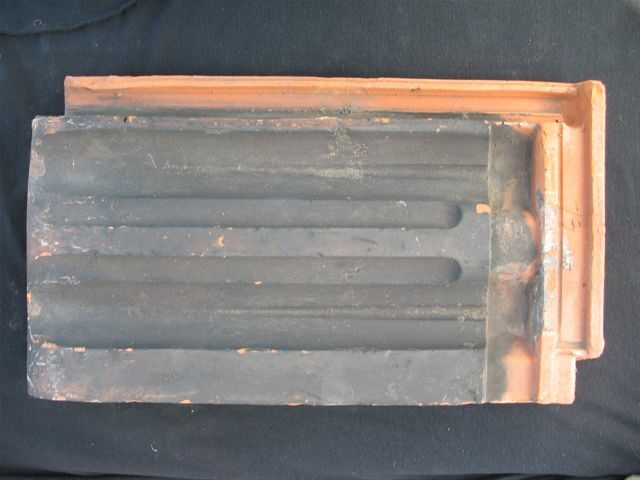 |
PROGRES HENNUYERES BELGIQUE | A long, narrow double-interlocking tile with a bold central vertical rib on front face characteristic of many continental tiles of this style. Laid in half-bonded (staggered) format. Differs from the Dutch patterns (Tegelen and Laumans) by virtue of having a deeper single left-hand drainage channel instead of a double-grooved design. |
 |
Romanette | As the diminutive of the name perhaps suggests, this is a smaller, more compact version of the larger Double Roman patterns. |
 |
SANDTOFT 20/20 (Mk I) | A small-format flat interlocking tile which although only developed within the last decade is already out of production due to being redesigned. This original single-nibbed pattern, which clearly shows its name on the reverse, is longer than the updated 'New Generation' version and has a T-shaped drainage channel within the headlap. This tile is available in repair quantities only. |
 |
SOMERSET | A long, slim and basically flat red clay tile from the town of Bridgewater in the county that bears its name. Manufacturers stamp usually visible on the upper part of the front face (i.e. within the headlap) but its main feature is the triangular "clowns hat" pattern central to the bottom edge. |
 |
Triple Rolls | A distinctive range of tiles with a corrugated/sinusoidal pattern available in a selection of sizes and a variety of profiles from the gently rounded to the almost angular. |
 |
D&G | A shallow double-interlocking pantile with distinctive "eyebrow"-shaped drainage channel across the upper face of the tile. Nail hole is down through nib on rear of tile. |
 |
D&G Bold Roll | A small but heavy interlocking tile (probably Dutch) combining a shallow pan with a tapering bold roll to the right hand side. |
 |
D&G Holland | A shallow double-interlocking pantile with "eyebrow"-shaped drainage channel across upper front face. Fractionally longer in its nett length than the standard D&G, it is secured through preformed nail hole in the face of the tile. |
 |
GEBR TEEUWEN TEGELEN | A long, narrow double-interlocking Dutch tile combining a shallow pan with a roll to the right-hand side. Has a series of distinctive support lugs spaced along the back of the tile. |
 |
HILLEROD TEGELVORK | A deeply profiled double-interlocking pantile from Holland. |
 |
JAC LAUMANS REUVER HOLLAND | A shallow double-interlocking pantile with 'eyebrow' style drainage feature to front face and preformed nail hole through upper interlock. |
 |
JD MADE IN HOLLAND | A shallow double-interlocking pantile with 'eyebrow' style drainage feature to front face and preformed nail hole through upper interlock. |
 |
L&H | A shallow double-interlocking pantile with "eyebrow"-shaped drainage channel across the upper front face. Nail-hole down through nib on rear face (like the standard D&G). |
 |
O & Z ROMAN 'S' | A small but distinctive and heavily-profiled interlocking tile from Holland combining a shallow pan and a large tapering bold-roll accounting for approx. 50% of the tile. |
 |
POTTELBERG COUTRAI (square) | A double-interlocking tile but with a flat-ribbed raised right-hand edge instead of the more traditional roll associated with small-format tiles from this Belgian factory. |
 |
POTTELBERG Made in Belgium (Glazed) | A classic deep-profile double-interlocking pantile with 'eyebrow' style drainage channel across upper face and finished with a rich deep brown ceramic glaze over the natural terracotta body of the tile. |
| STERREBERG Coutrai Made in Belgium | The classic name associated with this style of deeply-profiled double interlocking continental pantile, which has the distinctive 'eyebrow' style drainage channel across it's upper face. Available in natural terracotta or with a matt red or dark brown/black factory applied finish. | |
| UNNAMED | A small but thick and heavy flat plain tile with two solid nibs on the rear (probably Continental in origin) with a simple vertical interlocking channel unusually on its right hand side, meaning the tile is laid from left to right. |
If you have anymore questions about your tile that we haven't covered here, please get in touch with our team via email at enquiries@burtonroofing.co.uk
Alternatively you can call 0800 124 4431
